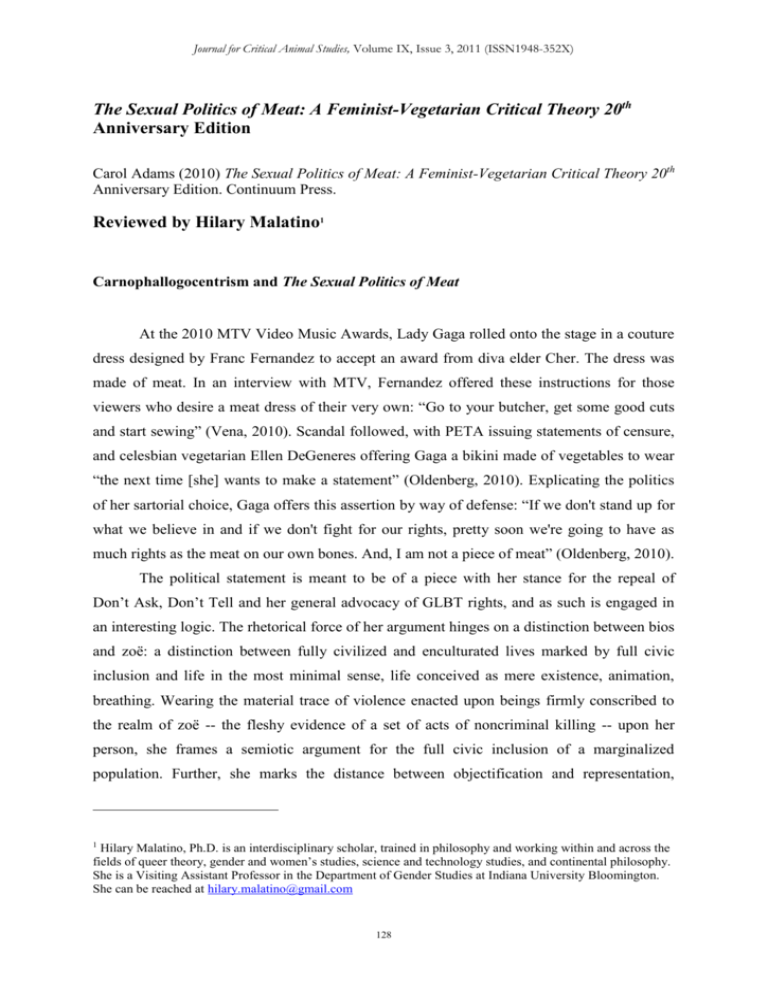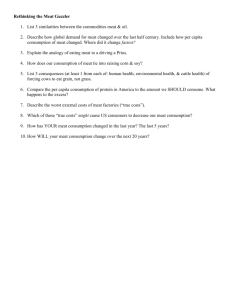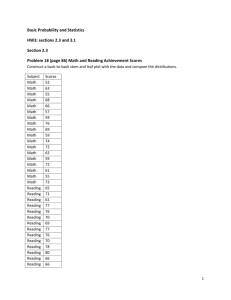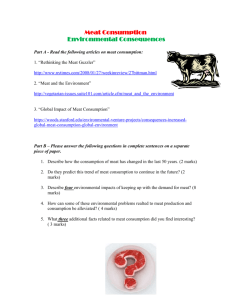
Journal for Critical Animal Studies, Volume IX, Issue 3, 2011 (ISSN1948-352X)
The Sexual Politics of Meat: A Feminist-Vegetarian Critical Theory 20th
Anniversary Edition
Carol Adams (2010) The Sexual Politics of Meat: A Feminist-Vegetarian Critical Theory 20th
Anniversary Edition. Continuum Press.
Reviewed by Hilary Malatino1
Carnophallogocentrism and The Sexual Politics of Meat
At the 2010 MTV Video Music Awards, Lady Gaga rolled onto the stage in a couture
dress designed by Franc Fernandez to accept an award from diva elder Cher. The dress was
made of meat. In an interview with MTV, Fernandez offered these instructions for those
viewers who desire a meat dress of their very own: “Go to your butcher, get some good cuts
and start sewing” (Vena, 2010). Scandal followed, with PETA issuing statements of censure,
and celesbian vegetarian Ellen DeGeneres offering Gaga a bikini made of vegetables to wear
“the next time [she] wants to make a statement” (Oldenberg, 2010). Explicating the politics
of her sartorial choice, Gaga offers this assertion by way of defense: “If we don't stand up for
what we believe in and if we don't fight for our rights, pretty soon we're going to have as
much rights as the meat on our own bones. And, I am not a piece of meat” (Oldenberg, 2010).
The political statement is meant to be of a piece with her stance for the repeal of
Don’t Ask, Don’t Tell and her general advocacy of GLBT rights, and as such is engaged in
an interesting logic. The rhetorical force of her argument hinges on a distinction between bios
and zoë: a distinction between fully civilized and enculturated lives marked by full civic
inclusion and life in the most minimal sense, life conceived as mere existence, animation,
breathing. Wearing the material trace of violence enacted upon beings firmly conscribed to
the realm of zoë -- the fleshy evidence of a set of acts of noncriminal killing -- upon her
person, she frames a semiotic argument for the full civic inclusion of a marginalized
population. Further, she marks the distance between objectification and representation,
1
Hilary Malatino, Ph.D. is an interdisciplinary scholar, trained in philosophy and working within and across the
fields of queer theory, gender and women’s studies, science and technology studies, and continental philosophy.
She is a Visiting Assistant Professor in the Department of Gender Studies at Indiana University Bloomington.
She can be reached at hilary.malatino@gmail.com
128
Journal for Critical Animal Studies, Volume IX, Issue 3, 2011 (ISSN1948-352X)
hijacking an interpretation of her celluloid visage as pornographic, sexually objectified and
complicitious with the ongoing oppression of women. The subtext of her claim to “not be a
piece of meat” is a literalist interruption of discussions of Gaga’s myriad performances that
circle around notions of positive and negative representation, around discussions of whether
or not her overtly sexual behavior renders her a less-than-desirable role model for teenage
girls. How could she possibly be a piece of meat, a thoroughly objectified being, when she’s
wearing the dead flesh of thoroughly objectified beings? Wearing the meat dress, she’s
selling autonomy, a politics of sartorial and sexual self-determination that is not at all
coterminous with sexual objectification.
I was re-reading the Twentieth Anniversary Edition of The Sexual Politics of Meat in
the midst of this meat-dress hoopla, and I kept returning to one ponderance: what does Carol
Adams think of this?
It’s nearly certain she would find the display in poor taste, violent, probably
pornographic. Gaga in her meat dress signifies, in a significant sense, as an only slightly
varied iteration of the iconic “Cattle Queen” image that graces the cover of The Sexual
Politics of Meat, featuring a woman garbed in only a red cowboy hat and traces of different
cuts – rib, chuck, loin, round, rump – across her flesh, posed next to script that reads “What’s
Your Cut?” Applying the feminist-vegetarian critical theory developed by Adams would
mean cognizing this performance of Gaga’s in a way that stresses a parallel or consanguine
relationship between the woman and the meat, a relationship of likeness between the
objectification of Gaga and the objectification of the dead animals she wears – in other words,
an interpretation exactly the obverse of the one Gage herself offers. I mention this
interpretive tension because I think that it indexes a much larger set of issues regarding the
relevance of The Sexual Politics of Meat to contemporary feminist theory and politics, vegan
and vegetarian praxes, and critical animal studies.
It would be easy discuss this text in terms of its tendencies toward a relatively
unvariegated and universalized notion of woman and, in keeping with this, a particularly
white and essentialist variety of radical feminism, and to then figure these tendencies as
politico-historical markers that consign the book to the dust-bin of U.S. ‘second wave’
feminism. Easy, but disingenuous. This is, after all, the Twentieth Anniversary edition of the
text, and it is a formative text for many. So rather than excoriating it on the grounds of its
political datedness, I’d like to approach the text considering what of it remains pertinent,
what of it continues to resonate, what of it is recuperable despite certain underdeveloped or
problematic presuppositions, and what of it may need to be seriously rethought.
129
Journal for Critical Animal Studies, Volume IX, Issue 3, 2011 (ISSN1948-352X)
Adams is, above all else, a radical feminist semiotician, a literary theorist dedicated to
examining and critiquing what she calls the “patriarchal texts of meat” (47), and The Sexual
Politics of Meat is, essentially, semiotic analysis enacted in a mode reminiscent of her mentor
Mary Daly, who was not content to merely deconstruct patriarchal metaphysics, but dedicated
to the creation of a separatist and gynocentric metaphysics. Daly’s approach to advocating for
vegetarianism is deeply ingrained in this text, which was conceived in one of Daly’s courses.
While Adams’ work is mainly guided by a critical impulse, it is politically oriented by a
utopic vision deeply informed by the essentialist feminism of Daly. This vision is clearly
extant in the preface to this edition, which begins with an exercise in feminist visionary
thought: “Imagine the day when women walk down streets and are not harassed, stalked, or
attacked. Imagine the day when we don’t need battered women’s shelters...” (1). This utopic
leaning becomes key to understanding the methodology deployed by Adams as she goes
about her research and writing. Not beholden to disciplinary constraints, and motivated by
nothing other than her political desires and a hunch that there is a relationship and set of
common political motivations that unite feminist and vegetarian epistemes and practices, she
draws upon radically diverse sources, working as a bricoleur as she builds what she calls a
feminist-vegetarian critical theory. Cited in the text are the journals of early 20th century
feminist vegetarian Agnes Ryan, porno mags, Mary Shelley’s Frankenstein, the 1988 BushDukakis presidential campaign, old cookbooks, and Margaret Atwood novels. Her research
archive is cobbled together from whatever seems to appear on her cultural radar that
addresses the intersection of women’s experience and eating – or not eating – animals.
Sometimes this approach to the quotidian elements that comprise the “patriarchal texts of
meat” elicits a response in the reader akin to what Walter Benjamin has called a profane
illumination – that moment when a banal object, advertisement, or colloquialism suddenly
sparks with a new meaning, casting light upon a connection between the oppression of
women and the brutalization of animals. This is in keeping with her conception of the book as
a consciousness-raising device, a text that, like the dialogic action within a C-R group,
“argues with the mythologies we are taught to live by until suddenly we are able to see the
same thing differently” (15).
Other times, however, her eclectic approach results in
suggestive, but otherwise seriously underdeveloped arguments.
I’d like to look at one of these latter instances, appearing in the preface to the
Twentieth Anniversary edition. In it, she likens her theorization of the relations between
feminism and vegetarianism to Derrida’s notion of carnophallogocentrism, utilizing personal
correspondence between herself and philosopher Matthew Calarco as an intermediary in the
130
Journal for Critical Animal Studies, Volume IX, Issue 3, 2011 (ISSN1948-352X)
mapping of this similarity. Calarco suggests that Derrida, in his addition of the prefix ‘carno’
to phallogocentrism, is iterating a linkage between masculinity and meat-eating similar to that
which Adams has been developing “in much more detail” (6). Phallogocentrism is a tripartite
conjunction of ‘phallus,’ used to denote not an anatomical penis, but rather the symbolic or
representative instances wherein the phallus is conflated with the signification of power;
‘logos,’ the Greek term for ‘word,’ ‘speech,’ and ‘reason’ that serves to highlight a particular
kind of privileged gendering operative in the realms of language; and ‘centrism,’ which
points to the organization of discourse around this conflation of reason and masculinity.
Derrida’s addition of ‘carno’ to this term imbricates acts of meat eating and animal sacrifice
as key to the discursive construction of subjects of Reason. Masculinity and carnivorism
work together to support the virility, power, and authority of one who argues, dialogues, and
speaks reasonably. This term, however, does not work to substantiate or fabricate a concrete
subject one could then point to and indict as ‘carnophallogocentric.’ To do this is to
misapprehend the deconstructive impulse generally, to substitute a metaphysics of presence
and absence for processes of differánce, to miss one of Derrida’s central points: that
carnophallogocentrism shapes certain subject positions, not that it creates and overdetermines
the meaning of determinate and individual subjects.
Yet this is precisely what Adams does, arguing that carnophallogocentrism
underscores the problematics of erotic images utilized in pro-vegan and vegetarian
advertising. She writes that “with Derrida (and Calarco’s help) we can comprehend the
problem when animal rights organizations chose to use pornographic ads to reach meat eaters:
they are speaking to the male subject and assume he basically cannot change. We who object
to the sexual politics of meat imagine something better. We imagine that the male subject
truly can change” (6). Rather than a complicated understanding of differential subject
positions, ways of gazing, and modes of perception, we have images of naked or near-naked
women posited as irrefutably ‘pornographic,’ a term that should be understood in the register
that anti-pornography feminists Andrea Dworkin and Catherine Mackinnon make use of it:
pornography is always violent-in-itself, always contributes to the fragmentation of what
should ideally be a whole being. Within this framework, the ostensible reduction of the being
of woman to her sexualized parts prompts viewers to construe women as constituted by body
parts to be utilized for sexual gratification, rather than as whole beings.
This understanding of pornography and its effects is extremely reductive, however,
particularly in an age wherein sites like vegporn.com deliberately embrace pornography and
wed it to a queer, feminist, and body-positive understanding of sexuality as well as an
131
Journal for Critical Animal Studies, Volume IX, Issue 3, 2011 (ISSN1948-352X)
animal-friendly, pro-vegan politics. Adams does not give us critical tools for understanding a
porn site like this, for rather than a plurality of desiring bodies and multiple sexualities, she
offers us a whittled understanding of sexuality and visuality that presumes only male subjects
gaze at ‘pornographic’ images of women, and that all images of women engaged in sexual
acts are necessarily pornographic, always violent, always harmful, always reductive. The
dyadic and non-internally differentiated male and female subjects at work in this assertion are
certainly not the troubled, haunted, and non-self-identical subjects theorized by Derrida; nor
are they queer, marked by different histories of racialization and class, and constituted by
many different sorts of masculinity and femininity. This rather clumsy ignorance of
intersectional thought – which insists on multiple differences that cross-cut and thus
destabilize monolithic conceptions of masculinity and femininity – as well as the multiple
poststructural problematizations of subjectivity shapes many of Adams’ most fundamental
assertions.
For instance, Adams characterizes women and animals as linked by a “fused
oppression” (102) under patriarchy that operates through language that pairs “‘meat eater’
with ‘virile male’ and women with animals” (102), thus suggesting “another pairing as well:
in talking about animals we are talking about a traditional female fate.” She argues that “we
oppress animals by associating them with women’s lesser status” (102). “Fused oppression”
is a term that indexes a shared and co-constitutive mechanism of oppression that manifests
linguistically, particularly through metaphor – the likening of women to animal, and viceversa. Both woman and animal are construed as “matter without spirit” – that is, objectified,
thing-like, instrumentalized – and Adams argues that “when one is matter without spirit, one
is the raw material for exploitation and for metaphoric borrowing” (73). Thus, metaphor is
violence, insofar as it absents, ignores, or elides a substantive subjective reality and facilitates
a series of equations that undermine the specificity of oppressions – for instance, when ecominded folks talk of the rape of the earth, they are making the rape of woman an “absent
referent,” as are folks who consume meat and refer to it with gastronomic language that
effaces the reality of the slaughter – for instance, using the word ‘veal’ instead of uttering
something along the lines of ‘baby cow, forcibly constrained and slaughtered.’
The notion of the absent referent is central to The Sexual Politics of Meat, functioning
as the lynchpin that sutures the oppression of women to the brutalization of non-human
animals. In ontological terms, the absent referent works to rend apart the spirit of women and
non-human animals from their corporeal matter; to rob them of full being in the form of
complete self-presence, the sort of being wherein one fully possesses themselves, their
132
Journal for Critical Animal Studies, Volume IX, Issue 3, 2011 (ISSN1948-352X)
actions, responses, and destinies. The absent referent works within a logic of presence and
absence, a dialectic of full being and mere matter that ties a categorically conceived and
universalized ‘woman’ to the non-human animal. Those of us working in queer theory,
feminist philosophy, and critical animal studies today must take seriously the problematics
presented by this foundational text, but we must also problematize the traditional ontological
underpinnings of the feminist-vegetarian critical theory offered by Adams. Adams seems to
understand being as shaped by an a priori subjective holism wherein matter and spirit are
enmeshed. This understanding of being orients the political project proposed by the text,
which can be glossed as the re-creation of a world wherein essences are somehow restored to
women and non-human animals alike; it proposes a feminist utopian world wherein women
and animals belong to themselves, and themselves alone, wherein each being is possessed of
its own essence. Given that many scholars working within the aforementioned disciplinary
and interdisciplinary realms – queer theory, feminist philosophy, and critical animal studies –
are deeply engaged in problematizing and rethinking the traditional philosophical dyads of
matter and spirit, male and female, animal and human, presence and absence, it is a thorny
process to engage a text that doesn’t trouble and destabilize these divisions. To embrace the
work done by Adams without addressing the ways in which her work relies on dichotomous
thinking is on some level to ignore the political engagements of communities who have
needed to destabilize these dyads to be perceived as legitimate political subjects – queer and
gender non-normative folks, peoples of color, peoples shaped by histories of forced migration
and colonization, “illegal” immigrants. Perhaps what we need to do is to think how these
political communities have been shaped in significant ways by the same dichotomous logics
of being that differentiate humans and non-human animals, that utilize this differentiation to
legitimate violence. This distinction is certainly operative in processes of racialization – one
need only look at 19th century western conceptions of species that posited peoples of African
and Asian descent as less-than-human, as bestial, as animal-like. Moreover, to embrace this
work is also to embrace a metaphysics of being that is not materialist, that accepts the
existence of ‘spirit’ as a matter of course – a considerable problem for many agnostic, atheist,
and/or Marxist vegetarians.
On some level, Lady Gaga suggests a more interesting path: there is a long Western
history of differentiating beings on a gradated scale of the fully to the non-human, a history
that the collapse of violence against women with violence against non-human animals elides.
Perhaps a better route to take is to insist on the non-coincidence of the existential
circumstances of the slaughtered animal and the objectified female body, in order to more
133
Journal for Critical Animal Studies, Volume IX, Issue 3, 2011 (ISSN1948-352X)
fully grasp the specific histories, technologies, materials, and modes of relation that constitute
these irreducibly different beings. This approach would also allow us to think carefully about
the deep subjective and communal differences that shape our current political and cultural
situations. Moving in the direction of specificity rather than conflation only sharpens our
engagement with questions of social justice.
References
Adams, C. (2010). The Sexual Politics of Meat.
Oldenberg, A. (2010). “Lady Gaga explains her VMA raw meat dress.” USA Today, [online]
Available at
<http://www.usatoday.com/communities/entertainment/post/2010/09/lady-gagaexplains-her-vma-raw-meat-dress/1> [Accessed June 15, 2011]
Vena, J. (2010). “Lady Gaga meat dress designer tells how to recreate his own look.”
MTV.com, [online] Available at
<http://www.mtv.com/news/articles/1647978/20100916/lady_gaga.jhtml> [Accessed June
15, 2011]
134









